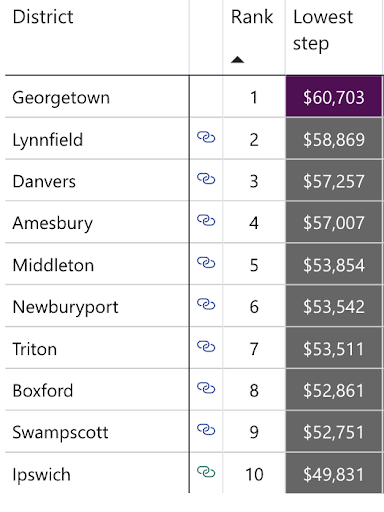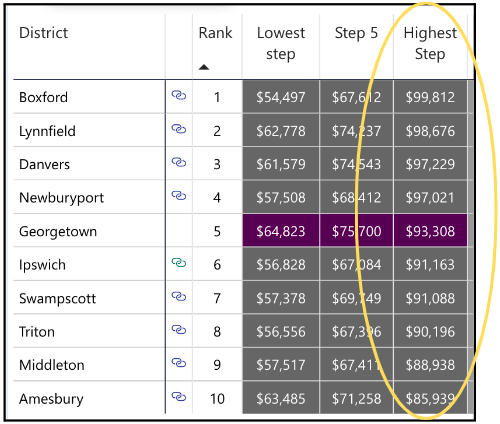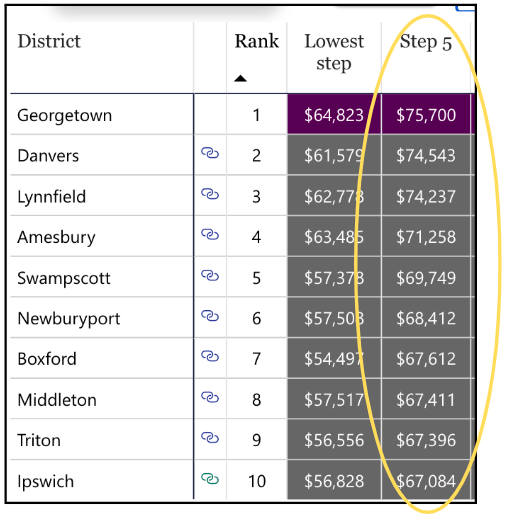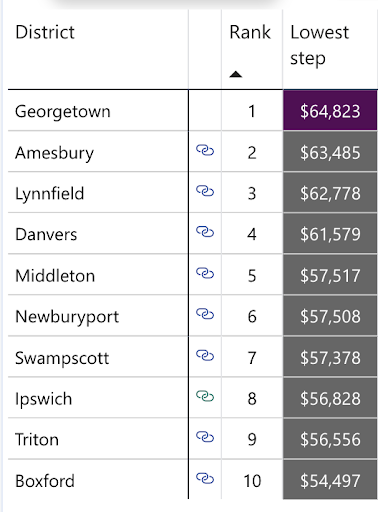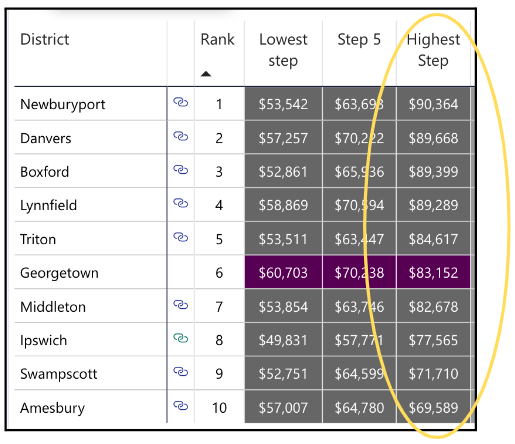Ranking Comparisons based on the SC financial proposal
Georgetown Education Association Proposals in Discussion
The Georgetown School Committee negotiations team has no open proposals other than salary and wages. The following are Georgetown Education Association’s open proposals.
- 403-B Plan Contribution – Currently GEA members receive the following:
- The employer will match up to $500 for members having 1-10 years of service
- For members having 11+ years of service, the employer shall match up to 1% of the member’s base salary
The GEA is proposing the following increases: - The employer will match up to $750 for members having 1-10 years of service
- For members having 11+ years of service, the employer shall match up to 1.75% of the member’s base salary
- Special Education IEP Meeting Caps: The GEA would is proposing the following language additional language:
- Members will have no more than 2 (two) IEP meetings per member per week. IEP meetings shall not infringe upon a teacher’s duty-free period. IEP meetings shall not exceed 1.5 hours each. Should a meeting require more time, the meeting will be continued at a later date
- Sick Leave language changes – Current language
- In addition to personal illness or injury, sick leave may be utilized for the following purposes:
- 2 days when emergency illness or injury in the family requires a teacher to make arrangements for necessary medical and nursing care
- 5 days for a critical illness in the immediate family
- Proposed Language is as follows: In addition to personal illness or injury, sick leave may be utilized for the an emergency illness or injury in the family that requires a teacher to make arrangements for necessary medical, nursing care or for a critical illness in the immediate family
- In addition to personal illness or injury, sick leave may be utilized for the following purposes:
Nuts & Bolts of Teachers Pay Scale
Georgetown teacher salaries, and most in Massachusetts, are structured using a “step and scale” system. Teachers move between the steps and scales based on their experience and education level and receive yearly pay increases as a result.
- Steps: Each step represents one year of teaching experience. As teachers gain experience, they move up the steps on the salary scale. For example, a teacher in their first year might be on Step 1, and after completing a year of teaching, they would move to Step 2, and so on. Even if the teacher contract had a 0% cost-of-living adjustment (COLA), teachers receive an increase in salary as they progress along the steps in the contract.
- Scales: The salary scale is based on the teacher’s educational qualifications (such as a bachelor’s, master’s, or additional degrees). As teachers complete additional graduate level education they would move on the scale. For example, if a teacher earns a Master’s degree they move on the scale, resulting in an increase in compensation.
School Committee Compensation Proposal
The School Committee created a compensation proposal that includes a restructured step and scale for teachers in addition to cost of living (COLA) increase for each year of the three-year contract. With nearly two-thirds of our teachers currently at the top of the scale, we recognize that we will need to recruit many teachers over the coming years, and we sought to make our pay scale as competitive as possible for new teachers – indeed, based on our information, Georgetown will pay starting teachers the highest salary when compared to neighboring districts.
The Georgetown School Committee proposal:
- Removes the top 2 rows of the scale, increasing the salary for new teachers entering the field. It also increases salary for our newer teachers by moving them to a higher step quicker than they would have otherwise.
- Adds additional rows to the bottom of the scale in the second and third years of the contract to add compensation for our most veteran teachers. This allows our teachers who have “topped out” on the scale to have a $1,000 increase each of the years, in addition to the COLA.
- The COLA is a total of 7.25% over the years including:
- Year 1: 2.5%
- Year 2: 2%
- Year 3: 2.75%
Most importantly, taken together, the range of compensation increases for the Georgetown School Committee compensation proposal is between 9.21% (veteran teachers who are at the top of the scale) and 28.77% (new teachers entering the field).
Georgetown School Committee, Three (3) Year Step/Scale Salary Proposal
The below information is a sample of salary projections under the School Committee proposal for the current teaching staff. It is important to identify that “step” is the number of years an educator has been teaching and “scale” is the education level of the educator. The FY25 column identifies where a teacher is today if the proposal is accepted. The FY27 column represents the same teacher in Year 3 of the contract. The number of teachers in each step and scale varies, but in FY25, 67% of the bargaining group (the last nine rows) are positioned in the highest step for their educational level.
| Step | Scale | Current Salary | FY25 Annual Salary | FY26 Annual Salary | FY27 Annual Salary | % increase |
| 1 | 1 | 53,851 | 60,703 | 64,351 | 68,615 | 27.42% |
| 1 | 7 | 57,168 | 64,823 | 68,866 | 73,613 | 28.77% |
| 2 | 1 | 56,890 | 60,703 | 66,778 | 68,615 | 20.61% |
| 2 | 4 | 58,399 | 62,229 | 65,925 | 70,232 | 20.26% |
| 2 | 6 | 59,383 | 62,229 | 65,925 | 70,232 | 18.27% |
| 2 | 7 | 60,551 | 64,823 | 68,866 | 73,613 | 21.57% |
| 3 | 1 | 59,222 | 63,089 | 66,778 | 71,133 | 20.11% |
| 3 | 4 | 60,711 | 64,632 | 68,352 | 75,223 | 23.90% |
| 5 | 1 | 63,872 | 65,469 | 69,229 | 73,613 | 15.25% |
| 5 | 2 | 64,376 | 65,469 | 69,229 | 72,733 | 12.98% |
| 5 | 7 | 68,525 | 70,238 | 74,429 | 79,338 | 15.78% |
| 6 | 1 | 66,216 | 67,872 | 71,643 | 76,126 | 14.97% |
| 6 | 7 | 71,190 | 72,970 | 77,214 | 82,198 | 15.46% |
| 6 | 8 | 72,192 | 73,997 | 78,265 | 83,272 | 15.35% |
| 6 | 9 | 73,188 | 75,017 | 79,303 | 84,341 | 15.24% |
| 7 | 1 | 68,525 | 70,238 | 74,089 | 79,729 | 16.35% |
| 7 | 5 | 70,527 | 71,774 | 75,646 | 81,340 | 15.33% |
| 7 | 7 | 73,854 | 75,700 | 79,998 | 85,417 | 15.66% |
| 7 | 8 | 74,859 | 76,731 | 81,043 | 86,490 | 15.54% |
| 8 | 7 | 76,516 | 78,430 | 83,131 | 91,143 | 19.12% |
| 8 | 11 | 80,951 | 82,975 | 87,735 | 95,965 | 18.55% |
| 9 | 1 | 74,218 | 76,074 | 84,815 | 88,175 | 18.81% |
| 9 | 7 | 79,513 | 86,965 | 95,174 | 97,792 | 22.99% |
| 9 | 8 | 80,512 | 88,008 | 96,314 | 98,962 | 22.92% |
| 9 | 11 | 83,917 | 97,202 | 100,146 | 103,900 | 23.81% |
| 9 | 12 | 85,546 | 93,233 | 101,720 | 104,517 | 22.18% |
| 10 | 1 | 81,124 | 83,152 | 85,815 | 89,175 | 9.92% |
| 10 | 2 | 81,658 | 83,152 | 85,815 | 89,175 | 9.21% |
| 10 | 3 | 82,218 | 84,831 | 87,528 | 90,935 | 10.60% |
| 11 | 7 | 91,033 | 93,308 | 96,174 | 99,819 | 9.65% |
| 11 | 8 | 92,122 | 94,425 | 97,314 | 100,990 | 9.63% |
| 11 | 9 | 93,226 | 95,557 | 98,314 | 102,176 | 9.60% |
| 11 | 10 | 94,832 | 97,202 | 100,146 | 103,900 | 9.56% |
| 11 | 11 | 95,665 | 98,056 | 101,017 | 104,795 | 9.54% |
| 11 | 12 | 97,293 | 99,725 | 102,720 | 106,544 | 9.51% |
Tentative Agreements Reached
Throughout the bargaining process the GEA Negotiating Committee and the School Committee have worked together to come to many tentative agreements. Here are some highlights:
- Sick Bank for GEA members which will allow members to donate and borrow sick time for those who have exhausted their accumulated time due to a prolonged illness. This will be jointly administered by the GEA and School Committee designees.
- GEA members will be compensated $200 for moving their teaching materials and supplies when they are involuntarily asked to move classrooms or spaces.
- The School Committee and GEA acknowledge the importance of a safe working environment and recognize the employer and employees obligation to foster a safe learning environment for all students and a safe working environment for all staff, teachers and paraprofessionals. To this end systems and structures will be collaboratively developed, and yearly training sessions will be held.
- Special Education teachers will be trained and supported to run their annual review meetings and receive time during the school day to develop student’s MCAS Alt portfolios.
- GEA members will receive two weeks of paid parental leave that will not be deducted from their sick time accumulation. The Parental Leave benefit now allows GEA members to take two weeks paid and up to eight weeks from accumulated sick time. In total, GEA members will be eligible for up to 12 weeks of parental leave.
- All GEA members will have weekly common planning time that will be collaboratively guided by educators and administration. This will afford teachers and administrators to work together on implementing the new curriculum, analyzing student data, and adjusting practices based on student needs.

